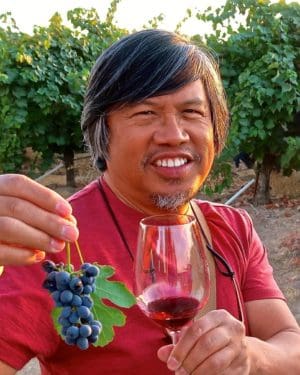A writer remembers words of wisdom from a true winemaking legend.
By Randy Caparoso
The late André Tchelistcheff, Beaulieu Vineyards‘ winemaker from 1938 to 1968, was a giant among men. Not physically — at about 5’3″, he made me look tall — but his deep, slightly slanted Russian eyes, nestled under thick, elvish brows, commanded military attention in every room where he stood, always ramrod straight.
In 2001, I attended a trade event called Sommelier Summit, where we were treated to a symposium of other legends in the California wine industry. The panel consisted of Robert Mondavi, Justin Meyer of Silver Oak, Jamie Davies of Schramsberg, Miljenko Grgich of Grgich Hills and Agustin Huneeus of (at the time) Franciscan and Quintessa. The vintners talked about the “Golden Age” of California wine in the 1960s. But all of their stories circled back to their collective mentor, André Tchelistcheff, the man whose rigorous, groundbreaking science and instinctive feel for terroir revolutionized California winemaking for all of them.
The importance of soil
I first formally interviewed Tchelistcheff for a local daily newspaper in 1983, on the island of Maui, where I asked him about soil, which to most Americans (including vintners) was, at the time, still a fuzzy subject. Said Tchelistcheff, “I am a great defender of the importance of soil, maybe more than anybody in America. I do not accept that technology or science alone can replace natural elements. [There is] no way.
“I’d like to be specific about Cabernet Sauvignon,” added Tchelisticheff. At that time, there were about 4,000 acres of the grape planted in Napa Valley (today there’s more than 18,000). Said Tchelistcheff, “California’s best red wine is Cabernet Sauvignon. Therefore it is planted everywhere. But within the 450 acres that we used to have in Beaulieu Vineyards, I only had 40 acres that were able to produce ‘Private Reserve.’ After more than 43 years in Napa Valley, I could locate just specific sections, with specific physical and chemical constitutions of soil, that could create great Cabernet.
“For [the French], the importance of soil is [simple], and more and more Californians are coming to the same conclusion. I can see that, eventually, we are going to have an appellation of origin system similar to France based upon soil and climate, dictating grape variety and production standards. But we are too young yet… we have to live another hundred years to reach that level.”
Economics over regulation
In retrospect, Tchelistcheff may have erred in a couple of ways. In 1981, the U.S. government had, in fact, established a system of American Viticultural Areas — and, within 40 years, more than 260 AVAs received official stamps of approval. The parameters for AVAs are based primarily on differentiations of soil, climate and topography.
Many pundits in wine-related industries would describe that as too much progress. American appellations are being established faster than average consumers or even wine professionals can comprehend them — or attach any significance to them. Still, it’s a good thing: the sooner wines can become associated with “sense of place,” the better.
Yet I suspect that Tchelistcheff’s prognostication of a “hundred years” before a French-style appellation system, one that regulates everything from grapes to wine production, can be instituted may never actually happen in America. Nor should it. Who’s to say what grapes should be grown in any given AVA, when they should be harvested or how wines should be made?
By the 2000s, for instance, Napa Valley became largely dominated by Cabernet Sauvignon, but that’s been happening for economic reasons rather than governmental regulations. Most of the land in Napa Valley is too expensive to plant anything besides Cabernet Sauvignon. If anything, it’s a damned shame, because Napa Valley can produce a much greater variety of interesting wines than just Cabernet Sauvignon.
Terroir is truth
Years later, in 1992, I sat down with Tchelistcheff for a second newspaper interview, and asked him about the latest viticultural advances I had been reading about — in particular, the new technology of trellising and canopy management, resulting in claims that even greater quantities of great Napa Valley Cabernet Sauvignon can be produced, as long as the fruit-to-leaf ratio on vines were kept in proper balance.
Suddenly a dark cloud seemed to roll over those thick brows, as he said, “That is rubbish! You should not believe everything you read! You must not forget that, when it comes to the vineyard, Mother Nature is still in charge, and Mother Nature has expressed her wish that great vineyards should grow only so much great wine, in only so many places. There is more Cabernet Sauvignon being grown in Napa Valley than ever, but there will never be more than a few of true ‘Private Reserve’ quality.”
You know what? As the years roll by and I repeatedly blind or double-blind taste Napa Valley Cabernet Sauvignons, I am still never surprised when a Beaulieu Private Reserve comes out on top, despite evolving winemaking styles. There are obviously a lot of great, flamboyant Cabernet Sauvignons coming out of Napa Valley today, but few are as consistent at hitting that middle mark of intensity, layering and elegance as B.V’s. At least for me, Tchelistcheff has yet to be proven wrong.
Hence, my own advisory: Don’t believe everything you read, or hear. Lately, there has been talk that terroir, for one, is a “myth” or “shibbolith,” a “marketing” ploy cooked up to separate the haves from have-nots. Viticulture and winemaking has improved everywhere, which has resulted in a sea of perfectly acceptable, often delicious, commercial wines, grown seemingly everywhere a grape can be grown.
All the same, our finest and most interesting wines remain those that are, not coincidentally, associated with specific appellations or vineyards. The concept of “place,” in other words, remains the same — dictated more by a proverbial Mother Nature than humankind’s vain compulsions to control every outcome of grapes. Tchelistcheff was a lot more right than wrong.
______________________________________________________________________

Randy Caparoso
Randy Caparoso is a full-time wine journalist/photographer living in Lodi, California. In a prior incarnation, he was a multi-award winning restaurateur, starting as a sommelier in Honolulu (1978 through 1988), and then as Founding Partner/VP/Corporate Wine Director of the James Beard Award winning Roy’s family of restaurants (1988-2001), opening 28 locations from Hawaii to New York. While with Roy’s, he was named Santé’s first Wine & Spirits Professional of the Year (1998) and Restaurant Wine’s Wine Marketer of the Year (1992 and 1998). Between 2001 and 2006, he operated his own Caparoso Wines label as a wine producer. For over 20 years, he also bylined a biweekly wine column for his hometown newspaper, The Honolulu Advertiser (1981-2002). He currently puts bread (and wine) on the table as Editor-at-Large and the Bottom Line columnist for The SOMM Journal (founded in 2007 as Sommelier Journal), and freelance blogger and social media director for Lodi Winegrape Commission (lodiwine.com). You may contact him at randycaparoso@earthlink.net




